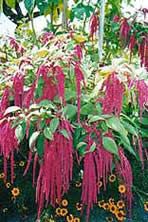

Amaranth (Amaranthus hypochondriacus)
Folk Names: Amaranthus, Floramor, Flower Gentle, Flower of Immortality, Flower Velure, Globe Amaranth, Green Amaranth, Huauhtli (Aztec), Lady Bleeding, Love-Lies Bleeding, Lovely Bleeding, Nun's Scourge, Pigweed, Pilewort, Prince's Feathers, Red Cockscombe, Red Root, Smooth Pigweed, Spleen Amaranth, Strawberry Blite (A blitum), Velvet Flower, Wild Beet
Description: Amaranth grows most abundantly in the tropics where it is an annual. It will grow wild in central US, and while it is not said to grow far north, we have some growing in our garden in Pennsylvania which come back from seed readily every year. The stem is stout and hairy, three to six feet. The root and lower stalks are red. The pointed leaves are alternate and oblong lanceolate, with red-purplish spots and reddish veins. The long clusters of red, fuzzy-looking flowers appear from August until the first frost.
Effects: gentle
Planet: Saturn
Element: fire
Associated Deities: Artemis
Traditions:
The name comes from Greek for unfading or un-withering because the flowers remain unchanged after drying. This made them a symbol of immortality, and they used to decorate images of the gods and at tombs. The flowers were often used in pagan burial rituals. The invading Spaniards outlawed Amaranth in Mexico due to their use by Aztecs in many rituals.
Magic:
The plant may be woven into a crown to speed healing or to confer invisibility upon the wearer. The dried flowers may also be added to rituals dealing with the dead and in ceremonies to mend a broken heart.
Pull up the entire plant, including the roots, on Friday during a full moon. Leave an offering in its place to the spirit of the plant and fold it up in white cloth. Carry this with you always over your chest as a preventative to ever being shot.
Known Combinations:
none known
Medical Indications: Parts Used : leaves
As an astringent tea, amaranth is taken internally for diarrhea, dysentery, hemorrhage, and excessive menstruation. As a wash, it is applied for skin problems, and it may be used as a gargle for mouth and throat irritations.
Nutrition:
Amaranth is used as a potherb in Jamaica and many other places. The seeds are ground into flour in India or may be added whole to bread flour. The leaves and tender stems may be eaten raw in salads or boiled for 10-15 minutes. For a dish of cooked greens, chop the greens, add onions, heat, and season as desired.
Mercantile Uses:
While not cultivated as an export crop, amaranth is high in nutrition. It is not only a healthy addition to the human diet, it can be used as a fodder herb as well.